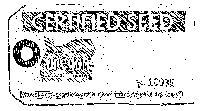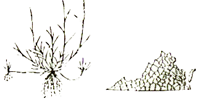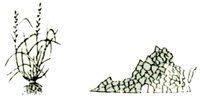 Introduction
Introduction
 Purchasing Turfgrass
Purchasing Turfgrass
 Turfgrass Varieties
Turfgrass Varieties
 Favorable Growing
Conditions
Favorable Growing
Conditions
A quality lawn results from using the right grass species
and/or variety, proper planting and establishment, and sound management.
Planting the right turfgrass for your site reduces the need for pesticides. The
most important step for the homeowner is selecting the proper turfgrass for the
situation.
Turfgrasses arc perennial, so arc expected to live indefinitely with proper
management. Because of this, choose carefully from among the various species and
varieties for each species. Turfgrasses that provide winter lawn color in most
areas of Virginia are known as cool-season grasses. Grasses which go dormant
after the first hard frost, and stay brown through the winter months arc known
as warm-season grasses. The warm-season grasses generally need less maintenance
as their water requirements arc lower, and their shorter growing season requires
fewer mowings per year.
Turfgrass species will not perform equally in the different climate, soils,
and management programs that are found throughout Virginia.
Northern Piedmont/Blue Ridge
For lawns of the Northern Piedmont and areas in and west of the Blue Ridge
Mountains, the cool-season species, Kentucky bluegrass or tall fescue, will
produce the best year-around turf on home lawns. Other cool-season turfgrasses
used for special purposes are fine leaf fescues (creeping red fescue, hard
fescue, chewings fescue, and sheep fescue) and perennial ryegrass. Fine fescues
have the best shade tolerance of all the cool-season grasses and arc often
included in a mixture with various Kentucky bluegrass varieties. Meyer
zoysiagrass, a warm-season species, can be used in light shade.
Southern Piedmont/ Eastern Virginia
In the Southern Piedmont and Eastern Virginia, tall fescue is the most commonly
used lawngrass. Bermudagrass and zoysiagrass (warm-season grasses) are also
adapted. If using bermudagrass, select a winter-hardy cultivar, especially if
you live in northern Virginia or in an area with a higher elevation.
Return to Table of Contents
Turfgrass can be established by seed, sod, sprigs, or plugs, depending on the
grass species and variety.
Certified Seed
 The best guarantee of getting the specific
variety or varieties of turfgrass is to purchase CERTIFIED SEED. It is a
guarantee from the seller that you will get the variety of seed named on the
label. Certified seed is generally available in 50 pound bags or larger. Some
nurseries will sell certified seed in bulk from bins or smaller packages; the
certified seed label should still be evident on the package from which seed is
dispensed. Avoid purchasing varieties that are not adapted to your area.
The best guarantee of getting the specific
variety or varieties of turfgrass is to purchase CERTIFIED SEED. It is a
guarantee from the seller that you will get the variety of seed named on the
label. Certified seed is generally available in 50 pound bags or larger. Some
nurseries will sell certified seed in bulk from bins or smaller packages; the
certified seed label should still be evident on the package from which seed is
dispensed. Avoid purchasing varieties that are not adapted to your area.
Sod
 Sod is rolls or pads of mature grass, cut
out of the ground with approximately one-half inch of roots and soil attached.
The sod is placed on a prepared soil providing immediate utility. Only high
quality, certified sod should be used. Such sod will contain Virginia- Maryland
recommended varieties which are free from noxious weeds and excess amounts of
other crop or weed plants.
Sod is rolls or pads of mature grass, cut
out of the ground with approximately one-half inch of roots and soil attached.
The sod is placed on a prepared soil providing immediate utility. Only high
quality, certified sod should be used. Such sod will contain Virginia- Maryland
recommended varieties which are free from noxious weeds and excess amounts of
other crop or weed plants.
Plugs and Sprigs
 Plugs arc small cubes of sod approximately
2 inches wide and 2 inches deep. Sprigs are stem fragments with young blades of
grass and bits of root attached. Be sure to obtain fresh material that is not
contaminated with unwanted weeds.
Plugs arc small cubes of sod approximately
2 inches wide and 2 inches deep. Sprigs are stem fragments with young blades of
grass and bits of root attached. Be sure to obtain fresh material that is not
contaminated with unwanted weeds.
Return to Table of Contents
The turfgrass species that do well in the different climatic areas of
Virginia are shown as a shaded area of each map.
Virginia and Maryland Extension recommendations for turfgrass varieties
change annually based on university performance tests. Check with your local
Extension agent for the most up-to-date list.
Kentucky
 Bluegrass
Bluegrass
A medium-textured turfgrass, it is best suited to welldrained soils and moderate
to high levels of sunlight and management. It is established from seed or sod.
Mixtures or blends of three or four Kentucky bluegrass varieties are
recommended in Virginia since they arc more likely to provide good quality turf
over a wide range of management situations.
Tall Fescue

A moderately coarse-textured turfgrass, it is tolerant of a wide range of soil
types and climatic extremes. Best suited to areas where low to moderate
management levels are provided. It is established from seed or sod.
Zoysiagrass
A warm-season grass of fine to medium texture, it will become dormant (turn
brown) with the first hard frost in the fall and green up in late April or
mid-May. It is not recommended at higher elevations due to its short growing
season. Improved varieties are only available as sprigs or sod.
Perennial
Ryegrass
 Perennial ryegrass is a cool-season grass
and performs best at higher elevations (> 1000 feet). The most common use for
perennial ryegrasses is in a mixture with Kentucky bluegrass where the perennial
ryegrass component is less than 15 percent by weight. A pure perennial ryegrass
lawn is not recommended. Annual (Italian) ryegrass provides rapid germination
and fast growth but is suitable only where a temporary turf is desired since it
lives for only one year.
Perennial ryegrass is a cool-season grass
and performs best at higher elevations (> 1000 feet). The most common use for
perennial ryegrasses is in a mixture with Kentucky bluegrass where the perennial
ryegrass component is less than 15 percent by weight. A pure perennial ryegrass
lawn is not recommended. Annual (Italian) ryegrass provides rapid germination
and fast growth but is suitable only where a temporary turf is desired since it
lives for only one year.
Bermudagrass
A warm-season grass, bermudagrass varies in texture depending on the variety. A
bermudagrass turf Will go dormant (turn brown) with the first hard frost in the
fall and green up in late April to mid-May. Best adapted in the Southern
Piedmont and Eastern Virginia, it is not recommended for higher elevations. It
can be est ablished from seed, sod, plugs,
or sprigs; however, some varieties cannot be seeded and must be established
vegetatively.
ablished from seed, sod, plugs,
or sprigs; however, some varieties cannot be seeded and must be established
vegetatively.
Return to Table of Contents
-
Soil 6 to 8 inches deep that allows good root growth by supplying adequate
water and nutrients
-
Soil pH of approximately 6.2
-
Adequate moisture (1 inch or more water per week)
-
Temperatures appropriate to the species selected
-
Adequate nutrients
-
Appropriate level of sunlight
-
Properly adjusted and sharp mower
-
Adequate air movement
If any of these conditions are not met on your lawn, corrective action should
be taken before attempting to establish turf. If it is difficult to grow turf,
consider planting a nonturf ornamental or use some other type of ground cover.
Return to Table of Contents
![]() Gardeners' Corner
Kids'
Garden
Sustainable Garden
Contact Us
Gardeners' Corner
Kids'
Garden
Sustainable Garden
Contact Us![]()



 The best guarantee of getting the specific
variety or varieties of turfgrass is to purchase CERTIFIED SEED. It is a
guarantee from the seller that you will get the variety of seed named on the
label. Certified seed is generally available in 50 pound bags or larger. Some
nurseries will sell certified seed in bulk from bins or smaller packages; the
certified seed label should still be evident on the package from which seed is
dispensed. Avoid purchasing varieties that are not adapted to your area.
The best guarantee of getting the specific
variety or varieties of turfgrass is to purchase CERTIFIED SEED. It is a
guarantee from the seller that you will get the variety of seed named on the
label. Certified seed is generally available in 50 pound bags or larger. Some
nurseries will sell certified seed in bulk from bins or smaller packages; the
certified seed label should still be evident on the package from which seed is
dispensed. Avoid purchasing varieties that are not adapted to your area.  Sod is rolls or pads of mature grass, cut
out of the ground with approximately one-half inch of roots and soil attached.
The sod is placed on a prepared soil providing immediate utility. Only high
quality, certified sod should be used. Such sod will contain Virginia- Maryland
recommended varieties which are free from noxious weeds and excess amounts of
other crop or weed plants.
Sod is rolls or pads of mature grass, cut
out of the ground with approximately one-half inch of roots and soil attached.
The sod is placed on a prepared soil providing immediate utility. Only high
quality, certified sod should be used. Such sod will contain Virginia- Maryland
recommended varieties which are free from noxious weeds and excess amounts of
other crop or weed plants.  Plugs arc small cubes of sod approximately
2 inches wide and 2 inches deep. Sprigs are stem fragments with young blades of
grass and bits of root attached. Be sure to obtain fresh material that is not
contaminated with unwanted weeds.
Plugs arc small cubes of sod approximately
2 inches wide and 2 inches deep. Sprigs are stem fragments with young blades of
grass and bits of root attached. Be sure to obtain fresh material that is not
contaminated with unwanted weeds.  Bluegrass
Bluegrass

 Perennial ryegrass is a cool-season grass
and performs best at higher elevations (> 1000 feet). The most common use for
perennial ryegrasses is in a mixture with Kentucky bluegrass where the perennial
ryegrass component is less than 15 percent by weight. A pure perennial ryegrass
lawn is not recommended. Annual (Italian) ryegrass provides rapid germination
and fast growth but is suitable only where a temporary turf is desired since it
lives for only one year.
Perennial ryegrass is a cool-season grass
and performs best at higher elevations (> 1000 feet). The most common use for
perennial ryegrasses is in a mixture with Kentucky bluegrass where the perennial
ryegrass component is less than 15 percent by weight. A pure perennial ryegrass
lawn is not recommended. Annual (Italian) ryegrass provides rapid germination
and fast growth but is suitable only where a temporary turf is desired since it
lives for only one year.  ablished from seed, sod, plugs,
or sprigs; however, some varieties cannot be seeded and must be established
vegetatively.
ablished from seed, sod, plugs,
or sprigs; however, some varieties cannot be seeded and must be established
vegetatively.